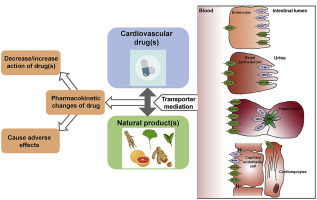当前位置:
X-MOL 学术
›
J. Food Drug Anal.
›
论文详情
Our official English website, www.x-mol.net, welcomes your feedback! (Note: you will need to create a separate account there.)
Transporter-mediated natural products–drug interactions for the treatment of cardiovascular diseases
Journal of Food and Drug Analysis ( IF 3.6 ) Pub Date : 2018-04-01 , DOI: 10.1016/j.jfda.2017.11.008 Weibin Zha 1
Journal of Food and Drug Analysis ( IF 3.6 ) Pub Date : 2018-04-01 , DOI: 10.1016/j.jfda.2017.11.008 Weibin Zha 1
Affiliation

|
The growing use of natural products in cardiovascular (CV) patients has been greatly raising the concerns about potential natural product-CV drug interactions. Some of these may lead to unexpected cardiovascular adverse effects and it is, therefore, essential to identify or predict potential natural product-CV drug interactions, and to understand the underlying mechanisms. Drug transporters are important determinants for the pharmacokinetics of drugs and alterations of drug transport has been recognized as one of the major causes of natural product-drug interactions. In last two decades, many CV drugs (e.g., angiotensin II receptor blockers, beta-blockers and statins) have been identified to be substrates and inhibitors of the solute carrier (SLC) transporters and the ATP-binding cassette (ABC) transporters, which are two major transporter superfamilies. Meanwhile, in vitro and in vivo studies indicate that a growing number of natural products showed cardioprotective effects (e.g., gingko biloba, danshen and their active ingredients) are also substrates and inhibitors of drug transporters. Thus, to understand transporter-mediated natural product-CV drug interactions is important and some transporter-mediated interactions have already shown to have clinical relevance. In this review, we review the current knowledge on the role of ABC and SLC transporters in CV therapy, as well as transporter modulation by natural products used in CV diseases and their induced natural product-CV drug interactions through alterations of drug transport. We hope our review will aid in a comprehensive summary of transporter-mediated natural product-CV drug interactions and help public and physicians understand these type of interactions.
中文翻译:

转运蛋白介导的天然产物-药物相互作用治疗心血管疾病
心血管 (CV) 患者越来越多地使用天然产物,这大大提高了对潜在天然产物-CV 药物相互作用的担忧。其中一些可能导致意想不到的心血管不良反应,因此,识别或预测潜在的天然产物-CV 药物相互作用以及了解潜在机制至关重要。药物转运蛋白是药物药代动力学的重要决定因素,药物转运的改变已被认为是天然产物-药物相互作用的主要原因之一。在过去的二十年中,许多 CV 药物(例如,血管紧张素 II 受体阻滞剂、β 受体阻滞剂和他汀类药物)已被确定为溶质载体 (SLC) 转运蛋白和 ATP 结合盒 (ABC) 转运蛋白的底物和抑制剂,这是两个主要的转运蛋白超家族。同时,体外和体内研究表明,越来越多的具有心脏保护作用的天然产物(如银杏、丹参及其活性成分)也是药物转运体的底物和抑制剂。因此,了解转运蛋白介导的天然产物-CV 药物相互作用很重要,一些转运蛋白介导的相互作用已经显示出具有临床相关性。在这篇综述中,我们回顾了当前关于 ABC 和 SLC 转运蛋白在 CV 治疗中的作用的知识,以及用于 CV 疾病的天然产物对转运蛋白的调节,以及它们通过药物转运改变诱导的天然产物-CV 药物相互作用。
更新日期:2018-04-01
中文翻译:

转运蛋白介导的天然产物-药物相互作用治疗心血管疾病
心血管 (CV) 患者越来越多地使用天然产物,这大大提高了对潜在天然产物-CV 药物相互作用的担忧。其中一些可能导致意想不到的心血管不良反应,因此,识别或预测潜在的天然产物-CV 药物相互作用以及了解潜在机制至关重要。药物转运蛋白是药物药代动力学的重要决定因素,药物转运的改变已被认为是天然产物-药物相互作用的主要原因之一。在过去的二十年中,许多 CV 药物(例如,血管紧张素 II 受体阻滞剂、β 受体阻滞剂和他汀类药物)已被确定为溶质载体 (SLC) 转运蛋白和 ATP 结合盒 (ABC) 转运蛋白的底物和抑制剂,这是两个主要的转运蛋白超家族。同时,体外和体内研究表明,越来越多的具有心脏保护作用的天然产物(如银杏、丹参及其活性成分)也是药物转运体的底物和抑制剂。因此,了解转运蛋白介导的天然产物-CV 药物相互作用很重要,一些转运蛋白介导的相互作用已经显示出具有临床相关性。在这篇综述中,我们回顾了当前关于 ABC 和 SLC 转运蛋白在 CV 治疗中的作用的知识,以及用于 CV 疾病的天然产物对转运蛋白的调节,以及它们通过药物转运改变诱导的天然产物-CV 药物相互作用。

























 京公网安备 11010802027423号
京公网安备 11010802027423号